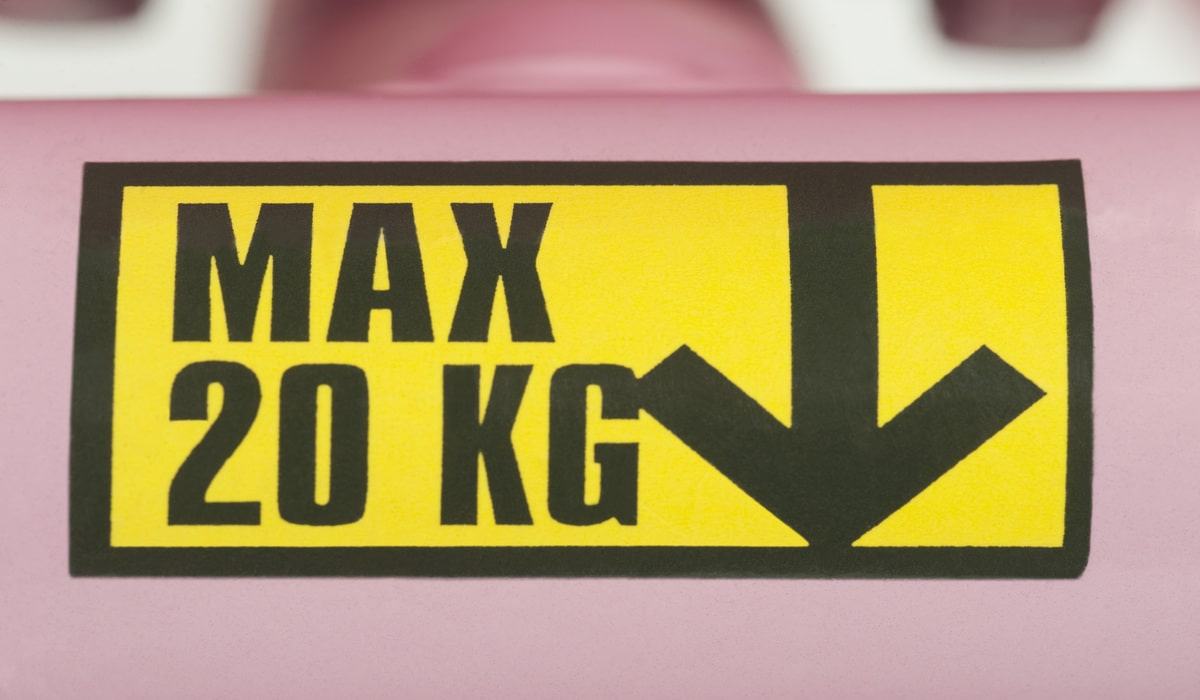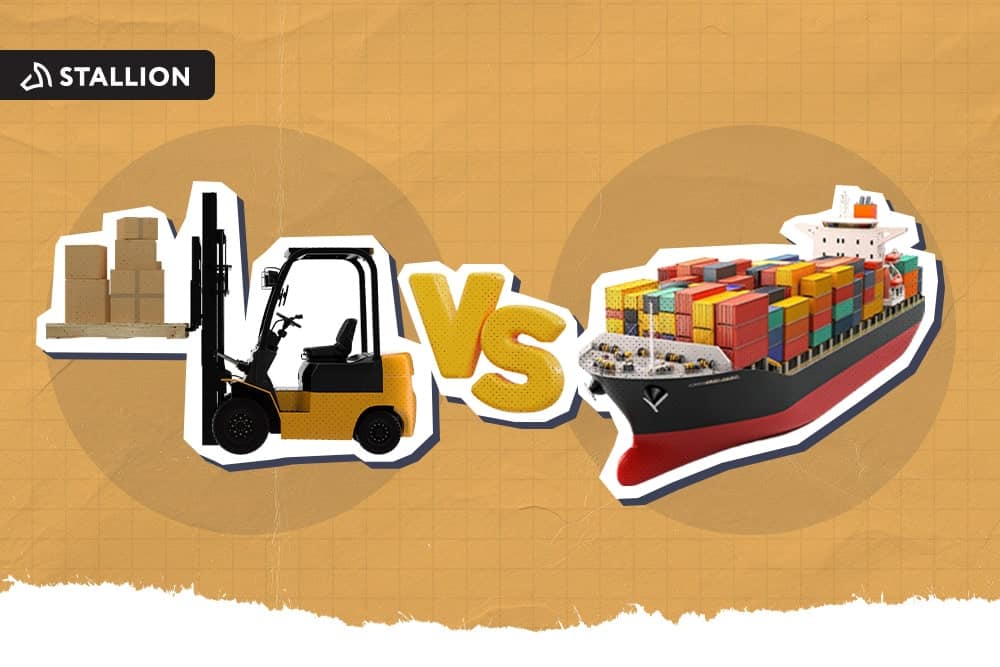
If you're a Canadian business involved in shipping and logistics, you're in the right place. Let this guide address the unique challenges that Canadian sellers encounter: understanding the weight limits of the major carriers in Canada, whether shipping products within your province, across the United States, or even internationally and understanding the ins and outs of weight limit is vital.
You'll see how these limits affect your day-to-day operations, providing tips on calculating and optimizing your cargo weight and figuring out the legal and logistical aspects you need to know for smooth shipping in the Canadian market. Let's get started!
It refers to the maximum weight a vehicle can legally carry to transport goods. These limits are in place to ensure road safety, protect infrastructure, and comply with regulations. Canadian sellers must consider when planning and executing their shipping operations.

For individuals and businesses engaged in shipping and logistics, having a comprehensive understanding of the package dimensions and weight restrictions imposed by major carriers is essential to ensure successful, economical, and compliant shipping operations.

The weight limits for parcels sent through Canada Post vary depending on the destination. The maximum weight for a package shipping within Canada or the United States is 30 kg (66 lb). Meanwhile, the maximum weight for international packages is also 30 kg.
Still, it's crucial to remember that additional weight restrictions may apply based on the specific laws and regulations of the destination country. Examining the weight constraints and any other potential limitations for your chosen overseas shipping destination is advised to ensure efficient and legal parcel delivery.
You can review the table below for specific size and weight restrictions:
Documents
| Requirement | Minimum | Maximum |
| Length | 140 mm | 380 mm |
| Width | 90 mm | 270 mm |
| Height | 1 mm | 20 mm |
| Length + girth | Not applicable | Not applicable |
| Weight | 50 g | 1.36 kg |
Parcels
| Requirement | Minimum | Maximum |
| Length | 230 mm | 2 m |
| Width | 200 mm | 2 m |
| Height | 25 mm | 2 |
| Length + girth | Exceeds the maximum dimension or weight of a packet | 3 m |
| Weight | 100 g | 30 kg |
Mailing Tube
| Requirement | Minimum | Maximum |
| Size | 100 mm x 23 mm x 23 mm | 2m x 2m x 2m |
| Length + girth | Exceeds the maximum dimension or weight of a packet | 3 m |
| Weight | 50 g | 30 kg |
1. Oversized items
A surcharge is applied to all items classified as oversized to ensure a fair and consistent shipping policy. An item falls into the Oversize category if it meets one of the following criteria:
This surcharge is imposed to account for the additional handling and space requirements necessitated by larger items, guaranteeing that shipping costs align with the size and demands of the transported packages.
2. Out-Of-Spec Surcharge
An item is categorized as "out-of-spec" if it surpasses the designated maximum size or weight outlined in the tables above. When an item is out of spec, a surcharge will be applied as part of Canada Post's shipping policy. It's crucial to understand that Canada Post has the right to take various actions, including refusing the item, returning it to the shipper, or proceeding with the delivery while applying additional fees to account for the non-standard shipment.
FedEx weight limit depends upon the service you opt for, ensuring the shipping experience aligns with the specific needs of your package. For example, FedEx Ground, FedEx Home Delivery, and FedEx Express maintain a maximum weight allowance of 68 kg (150 lbs) for commercial or residential purposes. On the other hand, FedEx Freight has a higher weight capacity, accommodating substantial cargo weights of up to 9072 kg (20,000 lbs).
Here are the points to remember when shipping with FedEx.
Purolator sets a standard carrier weight limit of 68 kg (150 lbs.) for all shipments. If the packages exceed this weight, they fall into the category of being over the limit, and, as a result, Purolator will not be able to accept them for delivery. This weight restriction ensures consistency and compliance with safety standards in Purolator's shipping operations.
Note that there are also guidelines to follow for special handling enhancements:
Special Handling Enhancements
| Special Handling Type | Definition and Parameters |
|---|---|
| Flat Package | The longest side must be greater than 45.72 cm (18 in) and equal to or less than (48 in), while the shortest side should be equal to or less than 5.08 cm (2 in). |
| Additional Handling | Items with high-risk contents that are not packaged in compliance with Purolator's approved standards or unboxed items (such as pails, crates, etc.). |
| Oversized | Weight should be more than 22.68 kg (50 lbs.) but no greater than 68.04 kg (150 lbs.), or the longest side must exceed 121.92 cm (48 in) while remaining equal to or less than 274.32 (108 in). |
| Residential Area Heavyweight | Weight exceeding 31.75 kg (70 lbs.) and delivery to sparsely populated residential areas. |
| Large Package | Girth should be greater than 330.20 cm (130 in) but no more than 419.10 cm (165 in). |
| Over Maximum Limit | Weights exceeding 68.04 kg (150 lbs.), girth surpassing 419.10 cm (165 in), or the longest side extending beyond 274.32 cm (108 in). |
DHL enforces a standard 70 kg (154 lbs.) limit for all shipments. Packages exceeding this limit cannot be accepted for delivery, ensuring uniformity and safety in DHL's shipping process.
You can check the table below for more information:
Standard Shipment
| Measurement | Length | Width | Height |
| Minimum measurement per unit | 15 cm | 11 cm | 3.5 cm |
| Maximum measurement per unit(for terminal-based transport) | 240 cm | 120 cm | 220 cm |
| Maximum measurement per unit for shipments with tail lift | 220 cm | 120 cm | 220 cm |
| Minimum weight per unit | No limit (except those pertaining to vehicle capacities and local country laws.) | ||
| Maximum weight per unit | 1 kg per item/package (international) | ||
| Maximum weight per unit for shipments with tail lift | 7.5 kg per item/package | ||
Standard Trailer Dimensions and Weight
| Measurements | Length | Width | Height |
| Outside Dimensions | 13.67 m | 2.50 m (2.55 m - Temperature-controlled) | 2.70 m |
| Inside dimensions | 13.5 m | 2.48 m | 2.63 m |
| Maximum weight capacity per trailer | 24 kg | ||
| Maximum number of europallet spaces per trailer | 33 (international) | ||
| Maximum number of europallet spaces per trailer | 32 (Benelux) | ||
| Maximum of bloc/industrial pallet spaces per trailer | 26 | ||
| Maximum cubage per trailer | 88 cubic meters: Standard economic use 79 cubic meters | ||
UPS imposes a consistent limit of 68.039 kg (150 lbs.) for all types of shipments. Packages exceeding this designated weight restriction will be categorized as exceeding the established maximum weight threshold and won't be accepted or processed for delivery by UPS.
Packages' length can extend up to 274.32 cm (108 in). However, it's important to note that your particular shipment's size and weight limits may differ. When packages exceed certain combinations of size and weight, it may be necessary to utilize freight shipping services. Understanding how to prevent measurement correction charges is crucial to ensure cost efficiency and accuracy. We also encourage you to visit the UPS Package Advisor page to view the specifications of each shipment.
The USPS has a consistent weight limit of 31.751 kg (70 lbs.) for all shipment categories. If the package exceeds this stipulated weight, it will be deemed oversized, and USPS cannot accommodate and process it for delivery.
Here are some of the definitions used by USPS when determining the package sizes and weights.
Note: If the calculated dimensional weight exceeds 31.75 kg (70 lbs.), the postage applied will be the 70-pound price. For Global Express Guaranteed® items not sent in USPS-produced GXG envelopes, pricing is based on either the calculated dimensional or actual weight, again choosing the higher of the two.
To further understand the guidelines set by USPS, you can visit their website for additional information,
For Canadian sellers, it's crucial to understand the weight restrictions applied to shipping, but what factors affect these restrictions? The essential factors determining weight limits will ensure you are well-prepared to negotiate the complexity of shipping and logistics successfully.
1. Carrier Policies
It's important to note that each carrier has its own requirements when it comes to weight restrictions. These weight restrictions can exhibit considerable variation from one carrier to another, emphasizing the importance of understanding and adhering to the specific weight limitations associated with the carrier you've chosen for your shipments.
Being well-informed about these carrier-specific weight regulations is essential for ensuring your products comply with the appropriate guidelines, which is vital for a seamless shipping experience as a Canadian seller.
2. Service Types
Weight restrictions also vary depending on the service you choose for your shipments. For instance, the choice between express services, ground shipping, and international shipping, frequently comes with varying weight limitations. These limit distinctions are designed to align with each service's unique demands and considerations.
Knowing how their selected service influences weight restrictions is essential information for Canadian sellers since it enables them to make wise choices, ensuring their products adhere to the proper weight guidelines and promoting a successful shipping experience.
3. Destination
Whether shipping within Canada, to the United States, or internationally, you'll encounter varying weight limitations and regulations. Each country or region may impose distinct standards, reflecting the need for localized considerations and restrictions.
4. Package Size
Carriers frequently impose restrictions on the weight and the combined dimensions, including the length, width, and height. Understanding how these dimensional considerations interact with weight limitations is crucial for Canadian sellers. It enables them to optimize their packaging and ensure their shipments follow the weight and dimension guidelines set forth by carriers, fostering a seamless and efficient shipping experience.
5. Special Handling
Specific item categories, including but not limited to hazardous materials, fragile goods, or oversized items, are subject to lower weight limits. These limitations are primarily enforced with safety and careful handling in mind. Shippers can ensure these items' secure and efficient transportation by accounting for these reduced weight thresholds, aligning with the specialized safety cargo.
6. Transportation Mode
Weight restrictions can vary depending on the selected transportation mode, whether by air, ground, or ocean. Each transport mode has a unique weight restriction set to accommodate that method's specific characteristics and capabilities.
7. Carrier-Specific Policies
Within the shipping and logistics industry, some carriers may introduce distinctive policies hinging on factors like the chosen service type, package content, or shipping location. These carrier-specific features may directly impact weight restrictions and shipping policies. Therefore, staying well-informed about these specific carrier policies is paramount for Canadian sellers.
8. Legal Regulations
The domain of weight limitations in shipping is also affected by numerous rules and regulations, including domestic legislation unique to Canada and global standards applicable to cross-border shipments. These legal considerations may significantly impact weight limits, particularly for specific goods or transportation types.
9. Shipping Fees
Weight is an important factor to consider since it significantly affects delivery costs. In general, bulkier packages are charged more for shipping. Understanding this essential idea will enable Canadian sellers to choose the most cost-effective packaging and shipping options, saving shipping costs while ensuring their product's safe and prompt delivery.
Calculating and estimating the weight of your packages ensures you choose the right service, pay accurate postage fees, and comply with weight limits set by carriers.
What are simple yet effective methods for calculating and estimating package weight?
To determine the weight of your cargo, use a reliable scale to weigh both the items being shipped and the packaging materials. Sum these weights to calculate the total cargo weight. Ensure the total weight falls within the permissible limits set by your chosen carrier to facilitate a hassle-free shipping process.
Accurate weight estimation is vital in shipping. Tools such as postal scales, kitchen scales, and shipping software are essential. Postal scales are precise and often come with rate calculators. Kitchen scales work well for smaller items.
Shipping software, like online calculators, can provide accurate weight estimates. In addition to these tools, check carrier guidelines and use a suitable shipping container. For larger items, freight scales are valuable. These methods and tools help ensure you meet weight limits and avoid surprises in the shipping process.
Precise weight calculation is crucial in shipping for several reasons.
Accurate weight calculation is fundamental for efficient, cost-effective, and secure shipping processes.
Maximizing carrier weight limits is essential for optimizing shipping efficiency and cost-effectiveness. By understanding and strategically utilizing these limits, Canadian sellers can ensure they make the most of their shipping options while avoiding additional fees and complications, ultimately enhancing their logistics operations.
Investing in accurate weighing equipment is advisable to ensure the precise calculation of your cargo's weight, accounting for factors such as packaging and pallets. Also, it's essential to be well-informed about the weight limits of your particular vehicle and the chosen transportation route.
This knowledge and reliable weighing equipment can significantly enhance the accuracy of your cargo's weight assessment, helping you avoid potential issues and ensuring seamless and efficient shipping for your goods as a Canadian seller.
To avoid overloading on specific axles, it's crucial to distribute the weight of your cargo evenly across the vehicle. Maintaining this balance helps ensure that your shipment complies with axle weight limits and, in turn, helps you steer clear of potential penalties or fines.
Proper weight distribution is a key consideration for Canadian sellers to ensure the safety of their shipments and regulatory compliance during the transportation process.
Optimizing your shipping strategy as a Canadian seller involves adopting efficient packaging and containerization techniques. These methods allow you to maximize the use of available space while still staying within the specified weight limits.
Additionally, it's beneficial to contemplate the use of lightweight packaging materials. These materials help decrease your cargo's overall weight, which can lead to cost savings and better compliance with weight restrictions, ultimately contributing to a more cost-effective and efficient shipping process.
Efficient planning of your loading process is essential for Canadian sellers. It can help minimize the occurrence of empty return trips and maximize the vehicle's cargo capacity. Additionally, making use of backhauls whenever feasible is a strategic approach.
This ensures that the vehicles consistently carry a full load, enhancing both the efficiency of your shipping operations and cost-effectiveness, which is vital for a successful shipping experience as a Canadian seller.
Navigating weight limits is crucial for Canadian sellers in the shipping and logistics industry. This set of frequently asked questions (FAQs) delves into the intricacies of weight limits, offering insights to help you understand and navigate these restrictions effectively in the Canadian market.
No, Canada generally maintains consistent weight limits for shipments across provinces. While there may be exceptions for certain specialized routes or unique circumstances, most shipments adhere to uniform weight limits established at the national level. It's essential for Canadian sellers to be aware of these standards to ensure compliance.
Exceeding the carrier's weight limit during transportation can have several consequences. It may lead to the carrier refusing the shipment, incurring fines or penalties, delays in delivery, redistribution of the cargo to meet limits, safety concerns, and potential liability for damage or accidents. Adherence to weight limits ensures safety, legal compliance, and a trouble-free shipping experience.
Yes, in some cases, exceptions or special permits are available for carrying overweight cargo. These permits are typically issued for specific routes and circumstances, such as transporting oversized or heavy machinery.
Carriers or shippers must apply for and obtain these permits from relevant authorities, which may include provincial transportation departments. However, obtaining such licenses is subject to stringent regulations and may involve additional fees. Researching and following the legal requirements for overweight cargo transportation in Canada is crucial.
Yes, you can request a weight limit waiver for specific situations or loads in Canada. These requests are typically made through provincial or territorial transportation authorities. The approval of a weight limit waiver depends on factors like the type of cargo, route, and safety measures in place.
Carriers or shippers seeking a waiver should contact the relevant authorities, provide necessary documentation, and adhere to the specified conditions if a waiver is granted. Remember that waivers are usually granted for exceptional circumstances and may involve additional fees or requirements.

Partnering with Stallion can offer significant advantages in various industries, from logistics and transportation to technology and beyond. The strategic collaboration with Stallion brings innovative solutions, expertise, and resources to your business, enhancing efficiency and competitiveness.
Whether you're looking to optimize supply chain operations or harness cutting-edge technology, Stallion's partnership can drive growth and success. Explore the possibilities of this dynamic alliance and unlock new opportunities for your business.
Stallion offers efficient and cost-effective domestic shipping services in Canada. With a focus on fast and secure deliveries, nationwide coverage, and transparent tracking, they cater to businesses' diverse needs. Stallion specializes in professional handling and customized solutions, ensuring reliable shipping solutions for their clients nationwide.
Stallion provides reliable US shipping services from Canada. They offer efficient cross-border shipping solutions, ensuring prompt and secure deliveries to the United States. With a strong focus on customer satisfaction, transparent tracking, and competitive rates, Stallion simplifies cross-border shipping for eCommerce businesses.
Stallion offers international shipping services, connecting businesses and individuals worldwide. Their comprehensive solutions ensure seamless and secure shipping to various destinations. With a commitment to customer satisfaction, competitive rates, and a strong network of global partners, Stallion facilitates international shipping, fostering a hassle-free global trade experience.
Aman looks after the content marketing department at Stallion Express. He is passionate about helping businesses grow by providing informative and up-to-date trends in the eCommerce industry. Outside the office, you can find him on the soccer field cheering on Real Madrid.



Can our fellow Torontonians relate?
-
#smallbusiness #business #entrepreneur #socialmedia #shipping #ecommerce #canadianecommerce #shopify #poshmark #b2b #saas #etsy #ebay #canada #canadiansmallbusiness #shoplocalcanada #entrepreneur
#toronto

Here’s your quick hassle free shipping from 🇨🇦 to 🇺🇸 as a business owner!
-
Any questions?! Leave them 👇🏻 and save this video so you don’t forget!
-
#smallbusiness #business #entrepreneur #socialmedia #shipping #ecommerce #canadianecommerce #shopify #poshmark #b2b #saas #etsy #ebay #canada #canadiansmallbusiness #shoplocalcanada #entrepreneur

Meet @drinkbenny a 🇨🇦 female founded energy drink brand! Instead of focusing on their products, they’re taking a unique approach by hosting in person events in different Canadian cities to offer an experience for their community 🧡
-
What are your thoughts on in person events? 💭
-
#smallbusiness #business #entrepreneur #socialmedia #shipping #ecommerce #canadianecommerce #shopify #poshmark #b2b #saas #etsy #ebay #canada #canadiansmallbusiness #shoplocalcanada #entrepreneur

Do you know the difference between DDU and DDP when shipping internationally 🌏 ?
-
Questions? Leave them below! 👇🏻
-
#smallbusiness #business #entrepreneur #socialmedia #shipping #ecommerce #canadianecommerce #shopify #poshmark #b2b #saas #etsy #ebay #canada #canadiansmallbusiness #shoplocalcanada #entrepreneur

Here’s a quick hack to save time from choosing multiple postage options
↪️ Turn on the lowest postage rate automation to save you time!
-
Questions? Leave them below! 👇🏻
-
#smallbusiness #business #entrepreneur #socialmedia #shipping #ecommerce #canadianecommerce #shopify #poshmark #b2b #saas #etsy #ebay #canada #canadiansmallbusiness #shoplocalcanada #entrepreneur
